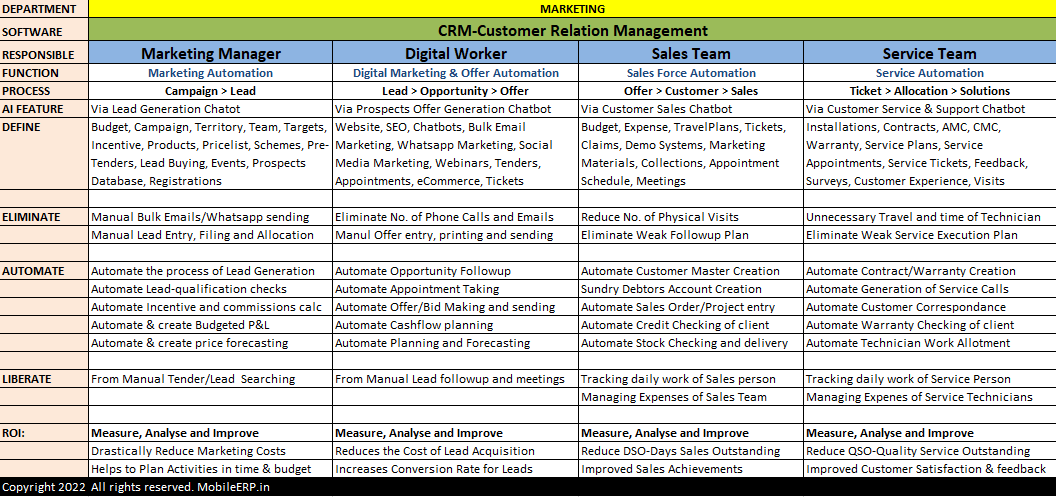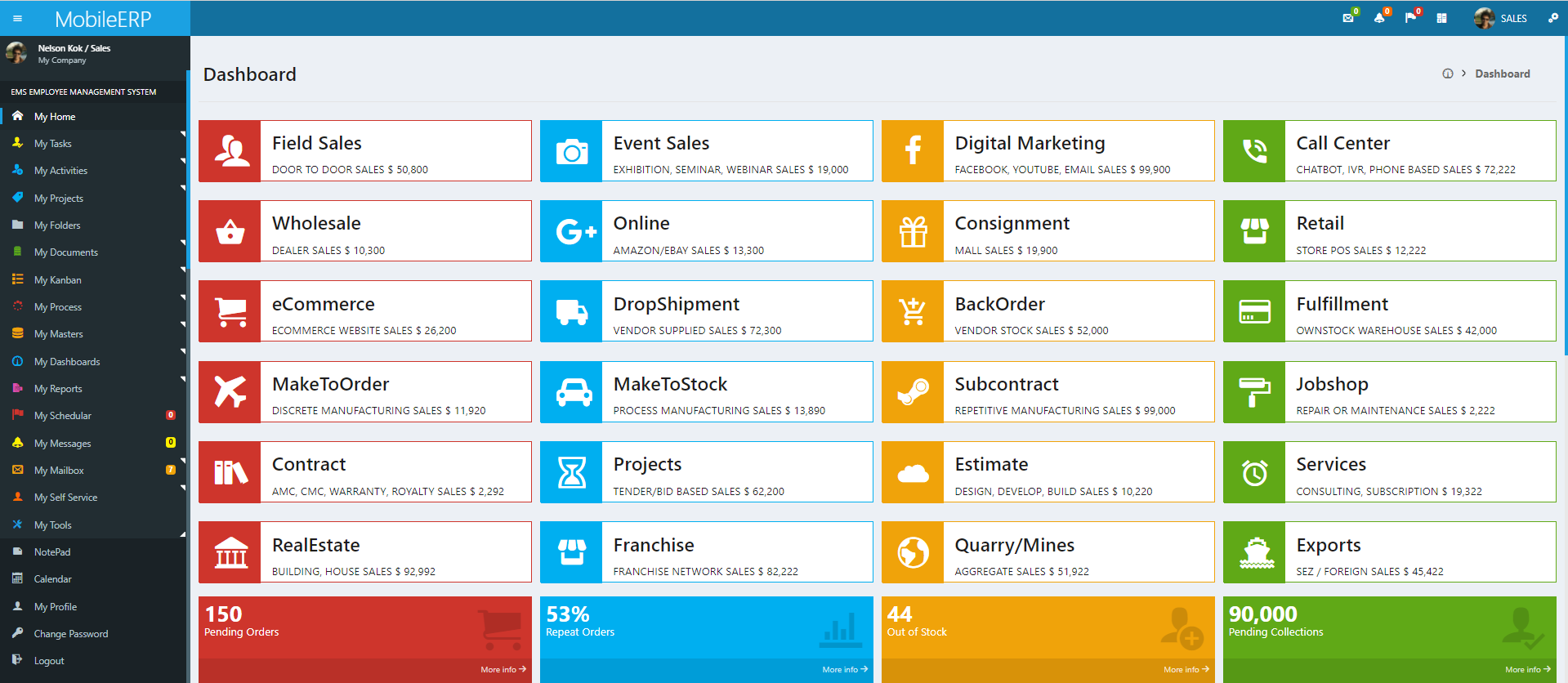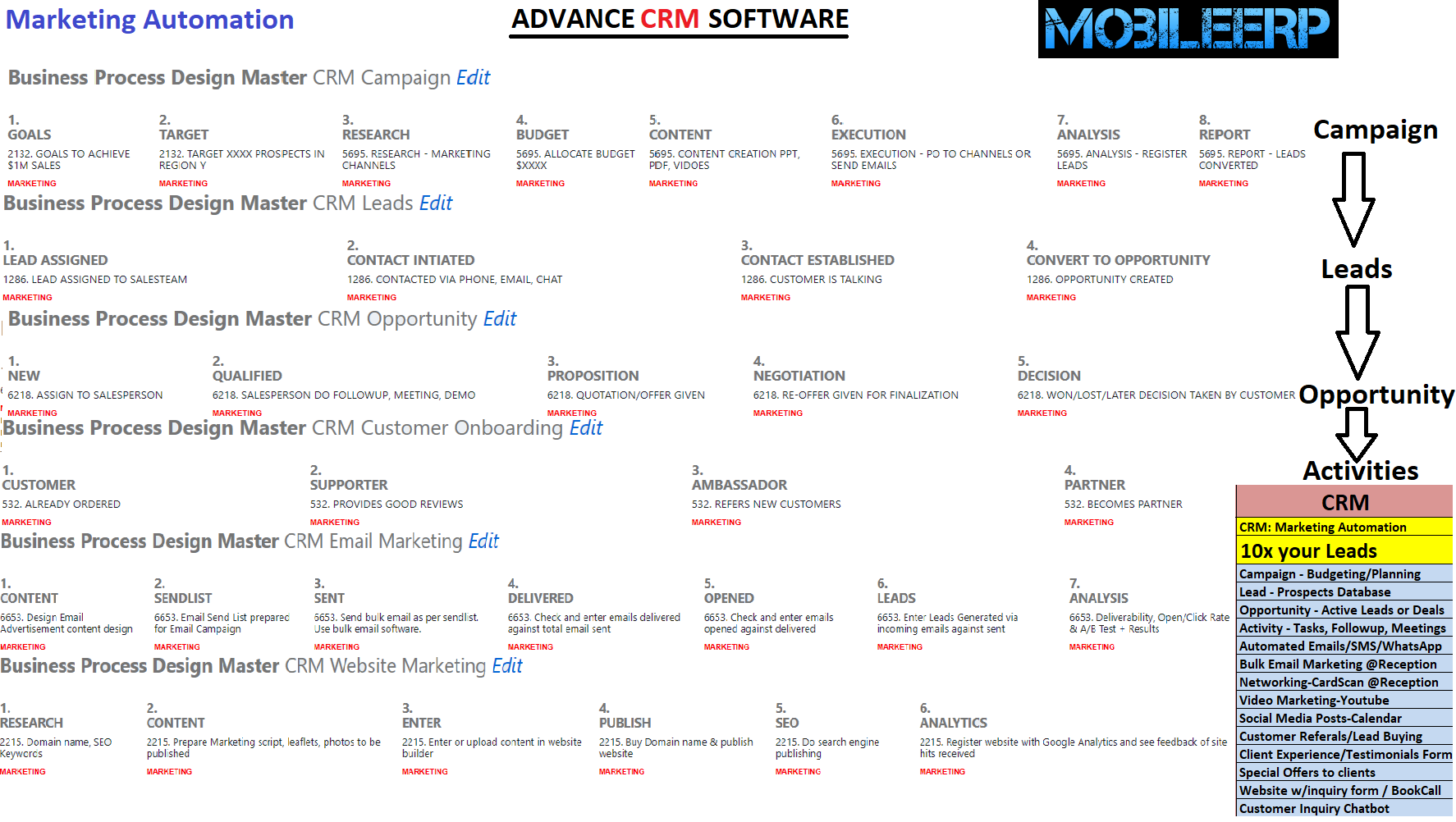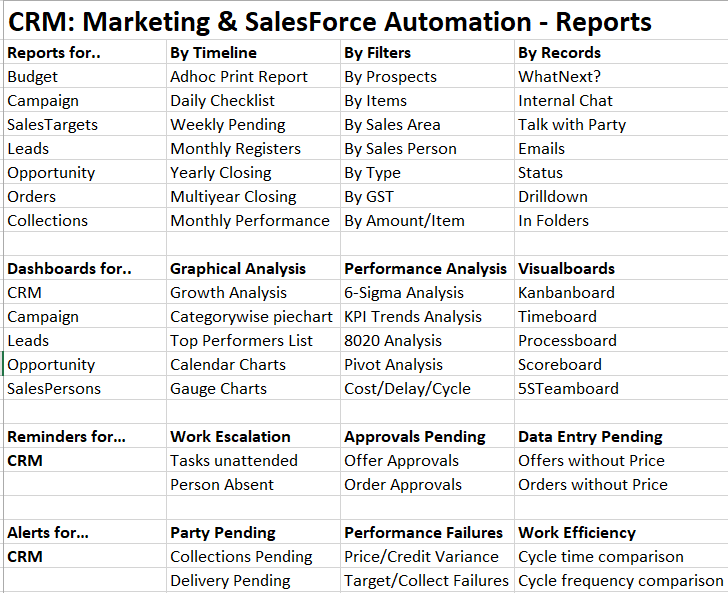Step 1
Acquire New Customers, Prospects, Territory
Step 2
Increase Sales and Profit from existing cutomers
Step 3
Retain Existing Customers and improve branding
Step 4
Measure Performance and Monitor overall system






Role: Salesmen1 / Year:2020 / Territorry: Assam
QUARTER1
Target: $42M
Budget: $5M
Campaign: $1M
Expenses: $1M
Balance Budget: $3M
Opportunity: $20M
LeadPipeline: $10M
Offers: $5M
Orders: $2M
Achievement: $2M
Collections: $1M
Incentive: $1k
QUARTER2
Target: $42M
Budget: $5M
Campaign: $1M
Expenses: $1M
Balance Budget: $3M
Opportunity: $29M
LeadPipeline: $11M
Offers: $5M
Orders: $2M
Achievement: $2M
Collections: $1M
Incentive: $1k
QUARTER3
Target: $42M
Budget: $5M
Campaign: $1M
Expenses: $1M
Balance Budget: $3M
Opportunity: $28M
LeadPipeline: $12M
Offers: $5M
Orders: $2M
Achievement: $2M
Collections: $1M
Incentive: $1k
QUARTER4
Target: $42M
Budget: $5M
Campaign: $1M
Expenses: $1M
Balance Budget: $3M
Opportunity: $22M
LeadPipeline: $14M
Offers: $5M
Orders: $2M
Achievement: $2M
Collections: $1M
Incentive: $1k
Simplify
1. Employee Work
2. Document Management
3. Management Reporting
4. Data Entry
5. Followups
Automate
1. Campaigns & Correspondance
2. Opportunity Generation
3. Lead Generation
4. Offer Preparation
5. Order Entry
Control
1. Costs
2. Employees
3. Collections
4. Process
5. Expenses
Eliminate
1. Duplicate Work
2. Rework
3. Repetitive Work
4. Travelling
5. Couriers
Understand the basics
What is CRM - Customer Relationship Management?
Customer relationship management is an approach to managing a company's interaction with current and potential customers. It uses data analysis about customers' history with a company to improve business relationships with customers, specifically focusing on customer retention and ultimately driving sales growth.

What is The future of CRM?. What are problems with CRM currently available in Market?. Why buy MobileERP CRM and not others?.
The future of CRM demands answers to some important questions: Is your CRM serving your customers or just serving your sales management? Does it make a difference?
So, so-called ‘modern CRM’ is really just a place for managers to go to try and pull together a forecast, piece together a part-fact, part-fiction account of their reps’ deals, and bring the new reps up to speed when they replace the current rep who fails to hit their quota. And we wonder why there is an adoption problem for CRM!
Adoption isn’t the only problem with CRM. The other problem is that the current incarnation of CRM doesn’t actually help you sell more either. Since 2011, the percent of reps attaining quota has been dropping . In fact, the drop has recently accelerated.
So, What Happened?
The problem is that the CRM industry has lost touch with reality. The reality of today is we need the simple 1-2-3 experience in everything we do. Amazon is a great example, you search, you add to cart and you pay. 1.2.3.
The point here is it’s simple and it adds value to your task. If Amazon was designed like today’s CRM, finding a product to purchase would consist of these tasks– write about what you plan to search for, search for something else, write a note that you searched for something entirely different, increase your probability of purchasing and update your likely purchase date…you get the idea. The exact opposite of the Amazon experience.
We believe that a static and passive database of contacts only adds so much value and does pretty close to nothing to spur new sales. And if the system of truth isn’t actually delivering truth, it’s making it far harder to diagnose problems and solve them.
What Role CRM Plays in your business?
Let's take a look at the role CRM plays in customer-centricity, customer data management and automation.1. Supports a customer-centric strategy
A CRM system supports a strategy which says that the customer is at the center of everything that you do. This customer-centric strategy must be based on clear goals and a vision of what a meaningful customer experience looks like.
A valuable customer experience is an integral part of CRM, according to Gartner’s report, “Improving the Customer Experience”.
Every time a customer comes in contact with an organization, through any of its channels, the customer has an opportunity to form an opinion – be it good, bad or indifferent. Through time, this collective set of customer experiences forms a picture in the customer’s mind, which in turn, forms the image of the brand its values.
Organizations that are serious about CRM design and maintain a quality customer experience because they recognize that a poor customer experience is a step toward customer churn, whereas a good experience encourages loyalty.
2. Centralizes all your customer data
CRM software combines all sales, marketing and customer service information into one central database.
With 92% of businesses collecting data on prospects and customers, having access to all data in database means fewer silos within your organization - thus helping you achieve customer centricity.
3. Automates customer-facing business processes
Companies have business-facing processes and customer-facing processes.
Business-facing processes are those which make the business run more efficiently such as budgeting and planning whereas customer-facing processes include sales, marketing and customer service.
A CRM strategy focuses primarily on the customer-facing processes and makes them better in terms of meeting the needs of the customer.
The following chart explains a sample what is included in each process:
Software Components of CRM:

CRM : MARKETING / SALES-Salesperson Portal / Offer/ Tender / Customer Service Management / Budgets and Expenses
What are types of CRM - Customer Relationship Management?
CRM can analyze data and generate reports whenever required. There are mainly three types of CRM applications – Operational, Analytical and Collaborative to perform all these activities.
What is difference between ERP and CRM?
ERP stands for “Enterprise Resource Planning.” ERP is designed to improve the efficiency of your business processes to reduce overhead and cut costs. But while CRM focuses on prospect and customer interactions, ERP focuses on all aspects of your business.
What are various components of CRM - Understand the difference between leads, opportunities, accounts, and contacts?.
1. Accounts represent companies that your organization does business with or are customers and will have sundry debtors account.
2. Contacts are people who represent an account. Prospects who could be potential customers also are Contacts. All customers are contacts, but all contacts are not customers.
3. Leads are potential or prospective customers. Leads are recorded and followp done so that an offer can be made by raising customer interest or customer relation and trust.
4. Opportunities are not a specific customer, such as a lead, contact, or account, and therefore require a customer record to be added to the opportunity.
5. Customers can be accounts, contacts, or leads. You can also use relationship roles to define how specific account, opportunity, and contact records are be related to one another in CRM.
Why CRM is important for your business?
CRM is more important than ever to businesses because it can help you to gain new customers and retain existing ones.
In today’s highly competitive environment and with so many products and services to choose from, customers are picky and customer loyalty seems to be a thing of the past.
The moment a new product is introduced into the market, it takes only a few months before that product or service suddenly becomes a commodity, which, in turn, means it’s easy to switch companies.
And despite what you might think, not all customers are created equal.
Some are a drain on customer service teams despite spending very little. Other customers do business frequently, often buy new products and services and may even be strong influencers in their market.
In cases like these, CRM helps prioritize sales and marketing efforts when dealing with different customer groups.
It also gives companies a better way of understanding customer needs and wants in order to improve the way the product portfolio is offered to them. The more you know about your customers, their buying preferences and behavior, the more likely your offer will be on target.
Marketing Automation
What is Marketing Automation?
 Marketing automation refers to software platforms and technologies designed for marketing departments and organizations to more effectively market on multiple channels online and automate repetitive tasks.
Marketing automation refers to software platforms and technologies designed for marketing departments and organizations to more effectively market on multiple channels online and automate repetitive tasks.
Sales Organization Setup

What is Sales Organization in CRM? Why Marketing Managers need to form and manage Sales Organization?.
Sales organization is a department in company within logistics that designs the company as per the sales requirements. Sales organization is held responsible for the sales and distribution of goods and services.
The selling unit is represented as a legal unit. The salesperson plays a crucial role in the sales company because he/she is answerable for many activities in the company. Some of those activities can be listed below.
Setting selling and profit objectives − The salesperson is involved in setting the objectives of selling the product and generating the profit.
Marketing policies − The salesperson has to set the marketing policies and plan accordingly.
Designing personal selling strategies − They also have to set up their own strategy to generate sales and to target and retain the customers.
They co-ordinate with other departments as well, for example, advertising, sales promotion and distribution, to chalk out a sales programme, which helps in generating sales. It also helps to find any loop holes and fix the issues.
Characteristics of a Sales Organization
Let us now understand the characteristics of a sales organization −A sales organization subsists of a group of people who handle different activities like distribution, advertising selling etc.
It works to achieve the sales objectives, like increasing sales volume and maximizing profit and market share of the company.
It specifies the responsibilities and duties of the salesperson and also co-ordinates their activities with other departments.
It helps to develop a relationship with the other personnel in the organization by setting up a sales programme.
General Sales Manager is the head of the sales organization.
Thus, sales organizations help the company in achieving targets and building coordination with sales personnel. Now we shall see the importance of sales organization.
Significance of Sales Organization
Let us now understand the significance of sales organization.To plan purchase
The sales of the company depend on the sales anticipation. The sales will increase only when the consumer purchases the goods or services. Therefore, the company has to plan the sales according to the consumer need and want, meaning where they want the product, what they want etc. The planning and development is done accordingly to satisfy the need of consumer.
To create pattern of demands for products
The demand of the product is created to lead to sell in the market. When a product is manufactured in the factory, it is not sold automatically. Salespersons push the product to consumers. But even they cannot force the consumer to buy the product. The sale depends on the consumer’s need and perception. This need is created by the selling skills, promotions through advertisements, etc., which in turn help in creating demand in market.
To handle the orders received
This is an important step where the salesperson has to answer the calls and queries of the customers, receive orders and make the product ready as per the demand of consumers.
Finally, the products are packed and dispatched as per the expectation of consumer; all these are imperative and effective tasks.
To collect the dues
Sales cannot always be done for cash. Bulk sales are made on credit. It’s very difficult for an organization to perform only on the basis of cash sales; in this competitive market, credit sales play a crucial role.
After the credit sales have been done, the organization has to collect dues. It is a very challenging task as the salesperson has to retain the business and still get the task done.
To handle the task of personnel management Every organization wants best sales personnel to enhance the sales. This depends on training. The organization has to select, train, motivate, monitor and control its sales personnel. Here the company has to make an investment in sales personal.
In summary, we can conclude that there is an immense impact of sales organization on a company.
Budget and Expense setup

Sales budget is a financial plan, which shows how the resources should be allocated to achieve forecasted sales. The main purpose of sales budget is to plan for maximum utilization of resources and forecast sales.
The information required to prepare a sales budget comes from many sources. One of the best sources is the salesperson who deals with the products on a daily basis. The company can also gather information from the production department regarding the date of manufacture or expiry.
It is very important to forecast the accurate sales because the budget of other departments is based on the sales budget. For example, the production is manufactured as per the sales forecast, but if the sales forecast is not accurate, either the production will be less or more than desired.
Objective of Sales Budgeting
The objective of sales budgeting is to plan for and control expenditure of resources (money, material, facilities and people) necessary to achieve the desired sales objective. It aims at leveraging and maximizing profits.The purpose of sales budget is to achieve the objectives of the sales department. It also acts as a planning tool. It helps a firm to set standards and strive to achieve them. It is also an instrument of coordination between different departments in an organization like sales, finance, production and advertising.
Sales budgeting is also a tool or control, which helps by comparison with the actual results. If the actual of sale is more than that of budget, we can say it is a favorable condition.
Methods of Sales Budgeting
There are a variety of methods which can be used to prepare a sales budget.The following are some of the popular methods to prepare a sales budget −
1. Affordable Budgeting
This is a method generally used by organizations dealing in industrial goods. Also, firms, which do not give importance to budgeting or firms which are having small size of operation, make use of this judgmental method.
2. Rule of Thumb
Such as a given percentage of sales. Companies involved in mass selling of goods and companies dominated by the finance function are the major users of this method.
3. Competitive Method
A few companies, the products of which face tough competition and many challenges in selling and which need effective marketing strategy to maintain profits, make use of this method. Using this method needs knowledge of how our competitor is working with regards to resource allocation.
Companies make use of a combination of the above methods. Depending upon the past experiences, budgeting approaches are refined time to time. The status of the sales & marketing helps the organization to figure out the extent of sophistication needed in approaching sales budgeting.
Preparation of Sales Budget
Preparation of sales budget is one of the most important processes of the sales. Generally, companies prepare the sales budget based on the principle of bottom up planning. Preparation of a budget for revenue and sales will depend on the sales organizational structure; each departmental head is asked to forecast their sales volume and expenses for the coming period.For Example, − in a leading automobile company, the budget would be prepared district wise and all the Budgets from each district would be submitted to the Regional office. Clubbing of all the District budgets is done at the Regional or Zonal level or Division wise. A division Budget is prepared and these Divisional wise budgets would vary product wise or market wise. So the Division wise budgets are finally submitted to the Manager, Sales as either product oriented or market group oriented.
Division wise budgets across all divisions would be submitted to the Central sales department and they would scan and finalize the company’s Sales Budget. Now the marketing budget is combined with the budgets of the sales and marketing staff departments, which will give a clear picture of total sales expenses, other marketing related expenses and approximate sales revenue generated for the company. Some of the common items in each sales budget include Employee Salaries, Administrative Expenses, Marketing Expenses and many more.
Direct selling expenses include boarding and lodging for salesperson, food and travel, and along with these −
-Commission or incentive based sales
-Employee benefits like medical insurance, gratuity and retirement contribution
-Office expenses like internet charges, mailing, telephone, office supplies
-Miscellaneous costs
-Advertising and promotional materials like −
-Selling aids
-Contest awards
-Product samples catalogues
-Price lists
-Other miscellaneous materials
Reviewing of past sales budget helps in better planning of future sales budget by informing about the pros and cons of the past budgets. This leads to better budget for future and can minimize the differences between the actual and the budgeted.
Communicating Overall Objectives
It is important for the top management to present their goals and objectives to the marketing department and argue effectively for an equitable share of funds. The chief sales executive of the firm should take the inputs from all supervisors and managers in preparing the sales budgets and encourage them to come with different ideas so that after the preparation of the Budget, they could take responsibility and show involvement in achieving the targets and implementing them.While preparing the sales budget, we need to set a preliminary plan so that we can allocate the resources and the efforts needed to sell the products, increase the customer base and territories. Any revisions in the Budget can be identified in the initial sales budget so that the sales manager could provide a realistic budget with maximum efficiency. Deviations should also be identified in each stage of development of sales budget.
As the budget is prepared by taking inputs from all levels of the hierarchy, the entire team would cooperate to achieve it. In case of failure, the sales manager should have control points in order to get the budget on track. He could also include some motivational factors like rewards, public commendations and recognition in the budget, which will motivate the employees to have a positive attitude, resulting in achievement of the budget goals.
Selling the Sales Budget to Top Management
There should be uniformity among the Budgets provided by different divisions. Top management of Sales and Marketing should propose the Budget that anticipates the future challenges and is competitive, along with the proposal submitted by the Heads of other divisionsEach and every division usually demands for additional funds and so there could be deviation from sales budget. These deviations should be addressed by the sales managers and they should justify each deviation in their budgets, as these would affect the profit percentage. In other words, there should be scope for deviations as well in sales budget.
Collection, Advances and Incentives Calculations

Incentives are granted as a % of salary, where 5% is granted to collectors who collect more than the average but less than the maximum, and 10% is granted to collectors who collect more than the maximum. A shortfall of this particular model is that the %'s of salary are low.
3 Ways to Improve Collection through Accounts Receivable Team Incentives
Want to get more from your accounts receivable team? Try offering incentives. Many companies have successfully implemented the following three programs, typically on a quarterly basis.
1. Actual Collection Dollars
If you are looking for increasing the number of dollars collected, offer incentives based on number of dollars collected. It gives your staff a number they can focus on every day or week. Simple daily goals to focus on will keep your team motivated, because they have some direct control over the amount of their bonus.
2. Target DSO-Days sales outstanding
If your DSO needs help, consider offering bonuses for reducing your DSO for the next quarter. Set a target that’s reasonably lower. Goals that are too high tend to demoralize rather than motivate. For example, if your DSO is at 50 days, offer a bonus if your team is able to reduce it to 45 days. If you want to get really aggressive about it, offer more for stretch goals, maybe even additional compensation if DSO is lowered to 40, 35, or 30 days.
3. Maintaining DSO-Days sales outstanding
Similar to the previous idea, except that your team has worked hard to reach a great DSO, and should be rewarded for maintaining that standard of excellence. Give your team props for consistency, especially if what they're doing is working.
Calculating DSO
Days sales outstanding (DSO) is the average number of days it for a business to collect payments for invoices. DSO is typically calculated based on the last 30, 90 or 365 days. To calculate DSO divide the amount of paid invoices to the during a given period by the total value of credit sales during the same period (i.e. paid invoices/open invoices over the last 12 months) and multiplying the result by the number of days in the period measured (365 days if using 12 months).